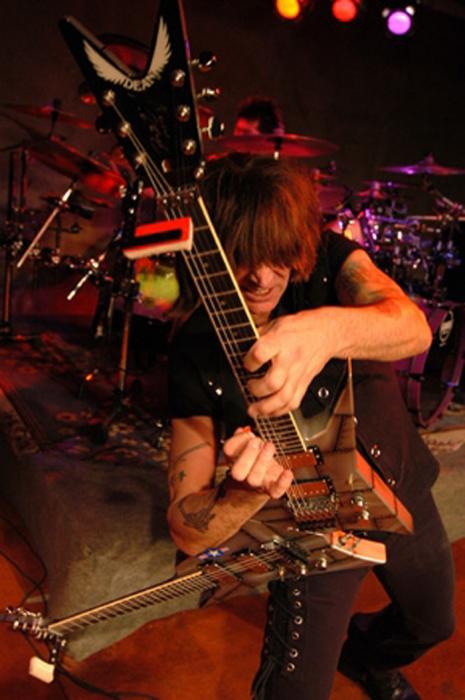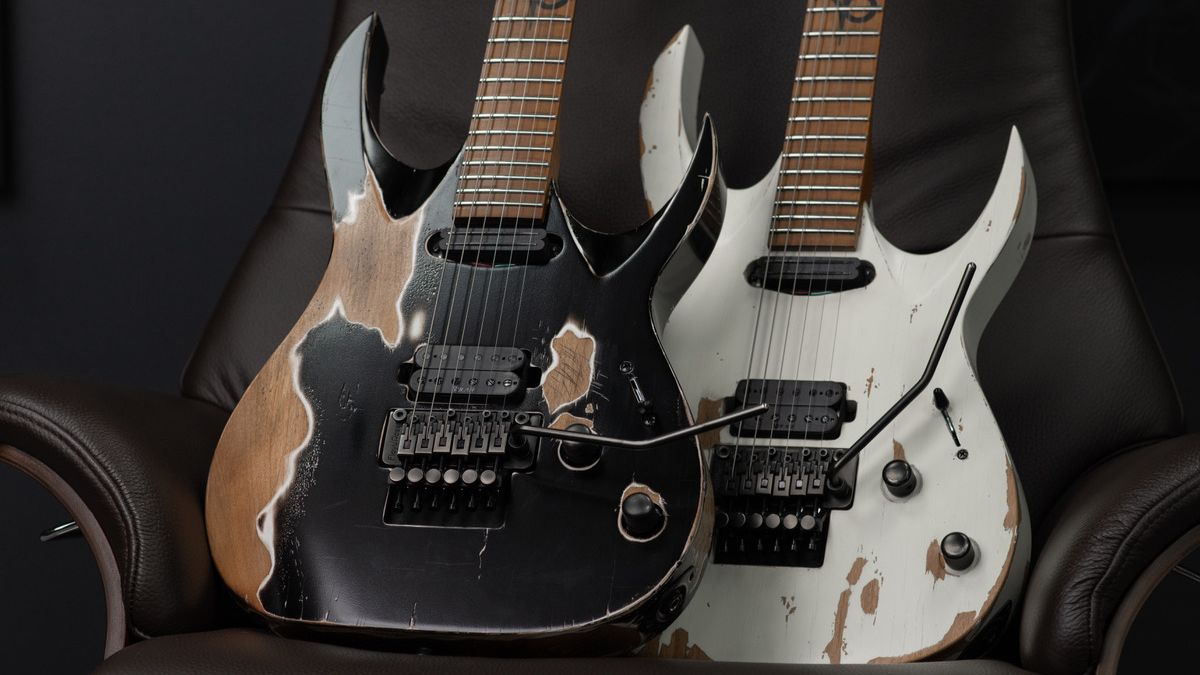Interview: Michael Angelo Batio Discusses Tone, Gear and His 'Speed Kills' DVD

Here's the second part of my recent interview with shredder Michael Angelo Batio. To see where we left off, check out part 1 right here.
Something your fans really dig is your tone. What kind of racks, gear, etc., do you use?
This is funny because I'm in my studio now, and I'm looking at hundreds of different effects. I have a guitar collection, a pedal collection and I'm looking at a 1960s Fender Fuzz Wah I just picked up in New York. I used to have one when I was a kid, and a volume pedal that slides to the right. I mean, it's just so freaky -- it actually looks like a ship or a zeppelin. Even with my show, I assembled this massive pedal board with the whammy pedal and all sorts of stuff. I took it all off.
My tone is an amp with the overdrive backed off. I have the mids as cranked as I can make them. Low bass, treble and presence wherever it's needed, and an overdrive pedal and my delay through the effects loop. That's my tone. I can get it 99 percent of the time through almost any amp, but I've got to keep the setup simple. I found the more gear I start adding, all of a sudden my tone starts to go away.
It's the signal chain. I like Morley wahs a lot, and they say there is no degradation in the sound. But I've noticed the more pedals one adds, for me, my tone gets less. And now when I record, I don't even use effects unless it's a wah or something for a part. I add the delay post, so it's really dry: guitar and amp and my overdrive pedal. That's the essence.
The older I get, that's just pretty much what it is. Even playing with Mark Tremonti -- there's a video on YouTube; he does a very similar thing, but he's got his delay like me, and he’s got the overdrive pedal, he's got a few more effects, but he can take them out of the signal chain and it still gets that really cool sound like mine when I play -- because he keeps it simple.
You're really into history, and I heard you recently visited the Shroud of Turin in Italy. What was that like?
All the latest guitar news, interviews, lessons, reviews, deals and more, direct to your inbox!
It was awesome. It’s in Torino, which is what the Italians call Turin. It's called the Royal Chapel in the Cathedral of St. John the Baptist. You walk into this place and see the Shroud. It's there, and you're close to it, but they don't have it where it's absolutely visible. It's not 100 percent on display right now.
That's not even the only thing. You walk into this church, and it's half a millennium old, and you see these artworks. They had this one fresco by this artist that was, you know, it's not like Michelangelo or any of the real famous ones, but it was incredible, and he’s showing people being boiled in oil, and I mean it's this really graphic violence in biblical terms. I walked around for a few hours just looking at the different art work and sculptures and different religious figures that were part of the church that are now like cast in stone, and it’ll say an Italian name and it'll be like the year 1430 through 1452, and I mean it's incredible. It gives you a really spiritual feeling.
You’re Italian too, right?
Yeah, but I'm actually more German then Italian. On my mom’s side, it's 100 percent Sudetenland German, but my dad’s side is Italian. A few other things mixed in, but all European.
You're such a Chicago fixture. Have you ever tried to perform the National Anthem for a Blackhawks game or a Bears game?
I did it. In fact, I was looking at the video just the other day. It's another crazy example of seizing an opportunity. I was playing at the NAMM show in 2002, and this was when I was still demoing stuff. Did you know I'm banned from doing that? It was maybe six or seven years ago and Dean had me play at their booth, and we had hundreds of people show up, and NAMM told them I wasn't allowed to play, that it wasn't a demo, it was a concert. And if I played on the floor again, they would shut the booth down. It was cool.
But in 2002, I was playing there and this guy came up to me named Derek, who works with the LA Kings. He said he was a big fan and he'd love to have me do the National Anthem. So I pick a date when the Blackhawks are playing the LA Kings, and they flew me out to the Staples Center in Los Angeles and put me up in a beautiful hotel. The day I picked was March 11, 2002, the six-month anniversary of 9/11, and they televised it nationally.
Doing all the session work for so many years as I have, they wanted it to be 90 seconds, so I had it like 88 seconds. I had timed it perfectly. It was perfectly played, and it was live. We had like a minute or two minutes between a commercial break to wheel the amps onstage, and I was on a 6-by-6-foot platform and we wheeled it on. They introduced me, I played, and they wheeled me off. It was awesome.
Did you have any idea that your Speed Kills instructional video would have such an impact on so many players?
Thanks, and no, I didn't. It's kind of nice now that time has kind of given me a place in guitar history, which is cool. My goal back then was to further the technical side of rock guitar playing. When you look at jazz guitar, and you look at classical guitar, and you look at different genres like Gypsy jazz, the playing as well as the music was of a virtuoso caliber. But rock wasn't. And there’s a few reasons.
One, the electric guitar is a much newer instrument than almost any popular instrument in the world. I mean the piano's got it by centuries, the acoustic guitar starting from the lute; it's 500 years old. So the electric guitar is 60 years old, give or take, so it's a new instrument. Rock was a new genre, so it had an evolution it needed to go through. I know my early CDs like No Boundaries still hold up technically. But that was the goal -- to say, "Look, the music’s always been great. No one can write a better rock song than AC/DC or Led Zeppelin," but I wanted the level of playing, the caliber of player to be elevated to the jazz and the classical status as far as guitar. And I think we did it. And my techniques stood the test of time.
It's one thing to be out there doing instructional programs and be a really great player. There are so many great players, and I think it's awesome. It's another one to be somebody like me who's like a pioneer of it and to go out year after year and tour and tour and tour. I know my technique’s been able to keep me from being injured and what I said 20 years ago, most of it, not every little thing -- there's a few things I've adjusted over the years -- but I think 90 percent of it still holds true today. And I think that's why it sold. And plus the look back then, my rocket guitar, and it was probably the best I’ve ever looked, you know. I was in great shape, so that didn't hurt either.
It's funny because Doug Marks from Metal Method, I've worked with him for a long time. We see these things as completely different things. He sees it as a lesson, which I understand, and that's why I like working with him. I see it as a lesson, but to me it's a statement of the time. That was that moment in time that was captured that cannot be recaptured. He is a business person, and he sees it as, well you can redo it. Which we did, we redid a new version, but I don't look like that anymore. I play better now, but it's still that moment in time that can never be recaptured. It was then and it was real. And there was no editing of the audio; we couldn’t even do it, It's impossible. It was linear film editing. It was videotape, but it was still tape. It wasn't on a hard disc. That technology was not available back then, so that's what I loved. It was real, in-your-face.
